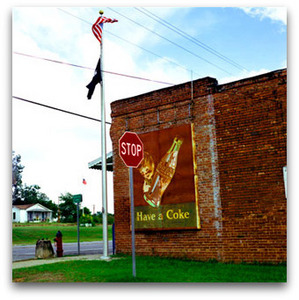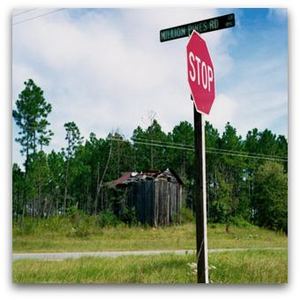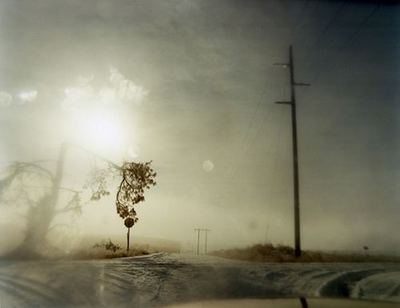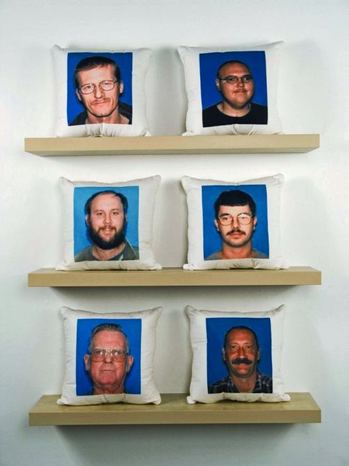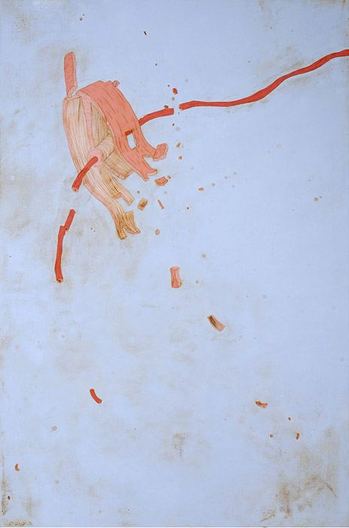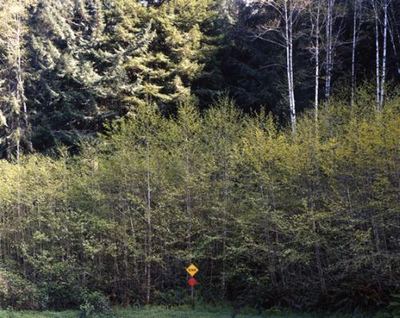Via.
Uncategorized
Dada economics – (art grants) no contacts, experience or talent necessary to win
Seattle’s Vital 5 finds the process of applying for grants demeaning and the results arbitrary. Hence, it launched its Arbitrary Art Grants.You don’t have to be good to win. On the other hand, if you’re fabulous, Vital 5 won’t hold it against you. $500 to each lucky winner. More here.
Last Friday, Vital 5 awarded another $500 dollars to somebody (anybody) with a sign protesting performance art in front of On The Boards, in honor of its NW New Works Festival.
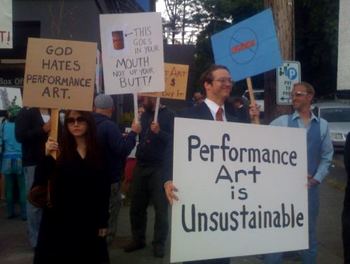 Photo, Dino Martini. Four in front, left to right: Emily Pothast (God Hates Performance Art); Steven Miller (This Goes In Your Mouth Not Up Your Butt!); Jed Dunkerley (Performance Art Is Unsustainable) and John Sutton of SuttonBeresCuller (unreadable from here).
Photo, Dino Martini. Four in front, left to right: Emily Pothast (God Hates Performance Art); Steven Miller (This Goes In Your Mouth Not Up Your Butt!); Jed Dunkerley (Performance Art Is Unsustainable) and John Sutton of SuttonBeresCuller (unreadable from here).
I love Pothast’s parody of her own interests. Ditto Miller, rabidly against what he cares about most (freedom). Dunkerley’s business consultant is a victim of his excessive self-esteem. If I were picking from the sample, Pothast would be picking up a check. Scoring aesthetically in this psudeo-protest, however, was of no value to the outcome, which is why so many artists turned out.
Links – art porn?
In her review of Dirk Skreber‘s exhibition at Fredrich Petzel, Art Fag City’s Paddy Johnson wrote,
Featuring two vagina-shaped crashed cars impaled on penile poles and bare-breasted paintings of super heroes, the show is the closest thing I’ve seen to pornography lately.
That’s a bad thing? First, it’s her idea that the smashed cars are vaginas. I like it, but it’s her metaphor. Second, although she has the advantage on me, having stood in the gallery instead of only seeing representations online, I’m pretty sure these sculptures aren’t anywhere near porn.
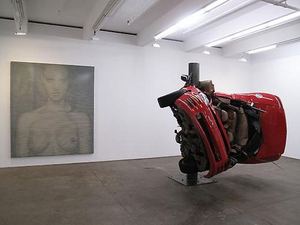 Porn is business. Ask your average male-seeks-female porn consumer if Skreber’s sculptures pass the porn test. They lack porn’s functionality. Like the Beatles in the late 1960s, porn loves to turn you on. Who’s turned on by these? I want to see hands.
Porn is business. Ask your average male-seeks-female porn consumer if Skreber’s sculptures pass the porn test. They lack porn’s functionality. Like the Beatles in the late 1960s, porn loves to turn you on. Who’s turned on by these? I want to see hands.
Because she interprets the sculptures as vaginas wrapping a phallus, she’s against them. At the risk of being an insensitive clod, I don’t see why aggressive sexual imagery has to be denigrated or denigrating. The heart is a corkscrew. Art from the heart doesn’t always dress for dinner or pass muster in a women’s studies class. My version of feminism does not foreclose on desires (even rage-filled desires) that have no victim.
In spite of stepping off the cliff from time to time (who doesn’t?), Johnson is essential. Here’s an example of why.
Kenneth Baker’s review of Squeak Carnwath at the Oakland Art Museum opens by acknowledging the broad general view and sympathizing with it:
It took me a long time to warm to Squeak Carnwath’s painting.
Twenty years ago, I regarded it as a self-involved pastiche of outsider-art mannerisms. But the Oakland Art Museum’s survey of the past 15 years of Carnwath’s work makes a nearly irresistible case for its authenticity and substance.
I’m not persuaded, but the review is so powerful I’m left feeling that I need to see this show before continuing to indulge a long-standing dismissal. On the other hand, a good curator can hide major faults and stress minor virtues, which might be all that happened here.
Baker again, on Robert Frank:
Part of Frank’s originality was to institute the photograph as a
membrane responsive both to a moment’s reality and the photographer’s
feelings about it.
Holland Cotter on the heart of the matter at the Met’s African/Oceanic survey:
In the Michael C. Rockefeller Wing at the Metropolitan Museum you’ll find a tiny African copper relief that probably predates, and would surely have awed, the great Lorenzo Ghiberti. You’ll encounter a bust of a Nigerian beauty to rival Nefertiti; an Oceanic Apollo with the physique of an Olympian; and a Micronesian statuette that is, with its stacks of faceted planes, Brancusi before Brancusi. (Review here.)
Cotter again, on Giacometti:
These portraits are laborious, noodling things, their lines repeated
over and over as if Giacometti were determined to create something
solid from nothing, then to obliterate that something. Far more relaxed
— and surely Giacometti drew as compulsively as he did to relieve
tension — are the drawings that look incidental, on the fly: an empty
studio interior, apples in front of a window, a pot of tulips, a tree.
Heaviness lifts; anxiety is dispelled. The faint lines of the tree fly
outward and upward like flames, evidence of a lightened-up, fly-away
artist that some part of Giacometti may always have wanted to be.
From Culture Monster, Daniel Nicoletta’s portraits of Harvey Milk, A life (cut short) in pictures, here.
Also from Culture Monster, David Pagel’s fine review of Kelly McLane: (Yes, description still mattters.)
In “Zero Gravity Madonna Lab,” plump pink babies grow like hothouse
tomatoes as older kids, in hermetically sealed bubbles, evoke science
experiments gone wrong. In “Flaming Arrow,” a sunny sky rains cherubic
cowgirls as a monstrous maw opens in the desert floor to devour
everything around it.Her paintings add depth and color to such point-blank encounters,
making the grand sweep of history come alive. If her oils and acrylics
on canvas were novels, they would have a lot in common with works by
Mark Twain, Wallace Stegner and Thomas Pynchon.
Pagel again: His review of Pae White is a thing of beauty:
Over the last couple of decades, Pae White has made art out of
almost nothing but thin air: a handful of cat whiskers affixed in a
drop of glue, a spray-painted spider web set in resin and the
shimmering reflections cast from a slab of mirrored Plexiglas sheets.
At 130PE, the light-handed artist
continues her lighthearted gambit, transforming incidental things into
instances of wonder that are ripe with delight.What’s new is the delicate touch of melancholy. Smoke and leaves are
the vehicles for White’s casually exquisite installation, which
consists of woven tapestries, laser-carved sheets of brightly colored
paper and hundreds of fake leaves, all made mechanically and many
painted, stained and shaped by hand.
From Jen Graves, definitive piece on commercial ventures borrowing or stealing from artists, here. Facts cited and complexities illuminated.
Graves again: She offers to take note in a public artist’s support group – real interviews in an imaginary frame. Funny, true and frightening, here.
From Sebastian Smee at the Boston Globe, a dud of a review of Matthew Day Jackson. Smee looks for polish and misses the power of the artist’s hungry heart.
Smee is in his 30s but writes as if he’s more than twice that age, cozying up to the audience as if he’s entertaining it over brandies in a men’s club. Even when he’s writing well, which is frequently, I feel like shaking the smug out of him. Maybe that’s all he needs – one good shake.
(Note to Smee: Get rid of most of your adjectives and step off your high horse. Treat your reading audience as if it’s a collection of intelligent but potentially dangerous strangers you’ve been hired to engage. Do not speak for them, pat them on their heads or presume to anticipate their reactions, and you’ll be fine.)
Doug Lansky – street signs
Via (Photo, Rod Campbell)

We’re all normal and we want our freedom.
Marat/Sade
Todd Hido – street sign
Buddy Bunting – the fine art of suffocating in the heat
Tomorrow’s the last day to see Buddy Bunting’s High Living at Crawl Space, including his 32-foot pen and watercolor wash drawing of the Two Rivers Prison in Oregon. (Show here, his Web site here.)
Jen Graves, from a review titled, Making Art While Nervous: Buddy Bunting’s Plein Air Prisons:
Buddy Bunting stakes out prisons. He parks by the sides of their roads to sketch, photograph, and videotape them in a hurry, before he gets caught.
Nobody is supposed to look too closely at a prison. Bunting does it in part because prisons are what he knows. Growing up in a Maryland area where a prison moved in and provided plenty of jobs, Bunting’s regular friends were prison guards as well as prisoners. He knows the in and the out, so he stands at the border and makes art.
(Her review here, with images.)
Most of the drawings in the current show derive from the Southwest. Solid objects are dematerializing in the heat and so are ideas, such as justice and a workable economy.
(Click to enlarge.)
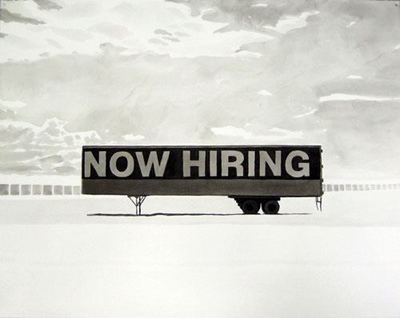 I’ve seen and greatly admired Bunting’s work over the years. This show is the show. I must have been in a coma to have forgotten to see it till its final weekend.
I’ve seen and greatly admired Bunting’s work over the years. This show is the show. I must have been in a coma to have forgotten to see it till its final weekend.
Considering how large a role prisons play in the U.S., they rarely make an appearance in art.
Bunting’s not the only artist in Seattle with a bead on them. Mike Simi was raised in a small Michigan town near near a large one. His dad, his uncle and his brother are prison guards. He happened to go to high school with nine of the 40 registered sex offenders in his area. No one in his family finds that fact remarkable.
Below, Simi’s from series of throw pillows titled, Sex Offenders From My Home Town, ongoing.
(Click to enlarge.)
Seattle’s Platform Gallery loses an owner
Five years ago, when Platform Gallery opened in Pioneer Square, it had four owners. Today, Stephen Lyons sent out an email to say he’s the only one left. Blake Haygood has decided to pack it in to focus on his painting.
Last
time I checked, a couple of months earlier, Lyons said the gallery was
not in debt. In five years, it has managed to break even, although it
never turned a profit. That’s five years without salaries from the gallery, as the
owners do not take money out for themselves.
The good news is,
Lyons intends to continue. (If you are a collector who asks for
discounts, think about who you’re asking them from.)
The
gallery’s contributions to Seattle are profound. It has raised the
tone, raised the ambition and made a point of connecting the local with the
global.
The many exhibits I am eternally grateful to have seen include Kelly Mark’s Stupid Love; Jesse Burke’s Dark States; Jaq Chartier’s Blind Sight; Scott Fife’s I Am What I Am and True Grit; Patte Loper’s Let Our Beauty Ease Your Grief and A Peculiar Brightness of the Sky; Adam Satushek’s In Between Days and, of course, everything from Matt Sellars and William Powhida.
I hope this doesn’t read like an obit. But Lyons is heading into the summer (always slow) with an at-best break even proposition in a terrible economy.
As for Haygood, contrary to the title of the painting below (I’m Not Really Sure It Matters from 2006), his work does and is well worth his renewed engagement.
(Click image to enlarge.)
Fred Muram to Chicago, Suzi Barrett burning in place in LA
Fred Muram is moving to Chicago. Soon. Let him Kiss The Ceiling in a crack house. At least he’s not going to LA.
Maybe he saw Suzi Barrett‘s I Hate LA. It takes the sheen off art’s magic kingdom. (Stop dropping names, shadow.) Via Bad at Sports.
Sharon Butler – street sign
From her photographic series documenting businesses named Moby Dick. Via.
Richard Renaldi again – street sign
California, 2005 (end)



